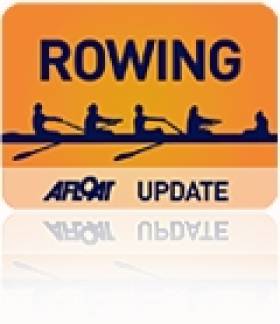Displaying items by tag: Rowing Ireland Grand League
Skibbereen on top as Grand League resumes with Limerick Regatta
The Rowing Ireland Grand League resumes this weekend following its break in July to accommodate the National Rowing Championships. This is the fifth in the series at Limerick regatta in O’Briens Bridge on Sat 21st Aug.
Skibbereen Rowing Club, who widened the gap at the top of Rowing Ireland’s Grand League following the Dublin Metro regatta in June, are expected to maintain their dominant position when the league resumes with the Limerick Regatta this weekend.
.
At the Metro regatta, the club increased its lead over nearest rivals, Dublin club, Neptune by 128 points. The lead is now significant making it difficult for Neptune to topple them at this stage. However St..Michael’s, Commercial and UCD will still be fighting it out for the coveted third spot.
The leading clubs going into this Saturday’s event are:
Skibbereen 573, Neptune 445, St. Michael’s 373, Commercial 358, UCD 262
St Michaels, Limerick lead the men's senior category on 195 points, with Neptune overtaking Commercial on 142 and UCD remaining in third on 121 points. UCD have maintained its lead in the women’s senior category on 141 points.
Skibbereen RC also remain top of the junior men category on 216 with Neptune overtaking St. Joseph’s, Galway (The Bish) in second on 120 with Lee Rowing Club in third on 101.
Skibbereen and St. Michael’s top the junior women on 125 and 80 points respectively.
Skibbereen, who collected three championship last month with wins in the Mens Junior Four, Womens Junior Four and Womens Senior Four and are now the third most successful club in the country in championship count, an impressive achievement for such a relatively small town.
Current League positions
1 SKIBBEREEN ROWING CLUB 573
2 NEPTUNE ROWING CLUB 445
3 ST MICHAEL'S ROWING CLUB 373
4 COMMERCIAL ROWING CLUB 358
5 UNIVERSITY COLLEGE DUBLIN BOAT CLUB 262
6 LEE ROWING CLUB 232
7 CORK BOAT CLUB 193
8 NATIONAL UNIVERSITY OF IRELAND, GALWAY, BOAT CLUB 189.75
9 CARRICK-ON-SHANNON 165
10 SHANDON BOAT CLUB 152
For full tables go to Results at http://iaru.ie/main.php
Click this link for the Latest Rowing News
Neptune Braced for Strong Challenge from Big Clubs
Neptune Rowing Club (Dublin) top the new Rowing Ireland Grand League table with two regattas under their oars but this could all change by next Saturday when the third regatta of the six series league takes place at the National Rowing Centre in Cork.
While Dubliners Neptune will be there in force with crews in most grades from under 14 to senior, they will be strongly challenged by the other big clubs, Skibbereen, UCD, Dublin Commercial and St. Michaels from Limerick. In particular, Skibbereen will compete strongly in mainly small boats. (Note: See current league standings below.)
Rowing Ireland spokesperson, Pat McInerney explained, “The overall entry for the regatta is well ahead of previous years which shows that clubs are embracing the new league format and enjoying the enhanced competition structure it offers.”
“From here on this season the top racing group of senior, intermediate and junior A will be collectively known as Division 1 while the novice, junior B and junior 16 group will be known as Division 2. With a massive entry of almost thirty junior 16 men’s single scullers, this is indicative of the health of sculling in the younger ranks and must augur well for the future.”
University of London, who are coached by former Irish lightweight rower, Brian Young, .are sending their men’s squad to challenge for senior eights, fours and pairs. They will line up in the eights against NUIG, Neptune, St Michaels, University of Limerick, Muckross and the top Junior eights of St Josephs and Presentation. This presents a very attractive prospect in store for the famed Leander trophy for eights which was first presented at Cork City regatta in 1904 when the world famous Leander club from London came to challenge for the trophy.
The Grand League offers an overall prize for top club based on all entries and this suits the bigger clubs. Smaller clubs can challenge for individual boat class or one of the four major categories of senior men, women, junior men and junior women
Current Grand League standings:
1 NEPTUNE ROWING CLUB 219
2 COMMERCIAL RC 206
3 SKIBBEREEN RC 192
4 UCD BOAT CLUB 171
5 ST MICHAEL'S ROWING CLUB 150
6 PORTORA BOAT CLUB 117
7 CARRICK-ON-SHANNON ROWING CLUB 102
8 BANN ROWING CLUB 93
9 LEE ROWING CLUB 86
10 GARDA SIOCHANA BOAT CLUB 83
Click this link for Irish Rowing detailsClick this link for the Latest Rowing News

























































